
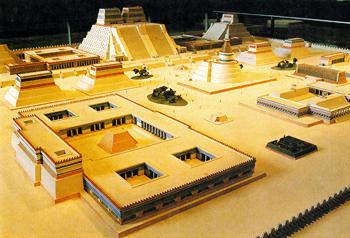
There are many references to the total depravity of the Aztecs -- but here is a good place to start:

Chichen Itza is not Maya -- it it Aztec -- Otza is Aztec.
A friend has been donated an incredible text about the conquering of Peten Itza -- Modern day Flores -- near Tikal -- that was set up by Chichen Itza - -and as was a major Aztec base.
These were the places they gathered their captured "meat" for the long
trek back to Mexico.


There are many references to the total depravity of the Aztecs -- but here is a
good place to start:
Note -- this is but a small snipette -- it is a huge page!!
http://www.pipelinenews.org/index.cfm?page=buzzaztecmedicine.htm
The Aztec were the America's version of the visigoths -- so to speak.
Even James Michener's classic about this area -- that starts in Cozumel -- give a good description of what the Maya were turned into after a 100 years of Aztec domination.
In order for each village to be allowed to surfvie they has to supply - -as tribute -- so many of their young each year -- as "cattle" to be marched off to Mexico and used for food.
Here is a scientific explantion:
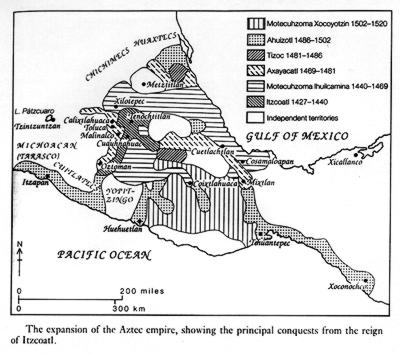
Science
12 May 1978
Vl. 200, No. 4342
pages 611-617
Aztec Cannibalism: An Ecological Necessity?
The Aztec diet was adequate in protein and cannibalism would not have contributed greatly.
Bernard R. Ortiz de Montellano
According to Boone's translation of the Codex Magliabechiano in her work, p. 213, human flesh was compared to the taste of pork. Boone further references that native Indians were fond of pork meat brought to New Spain after the conquest for this reason.
The actual glyph, contained in Nuttall's THE BOOK OF THE LIFE OF THE ANCIENT MEXICANS (The Codex Magliabechiano), folio 73, depicts more than a stew and in fact indicates whole body parts, heads, arms, legs and other parts, in earthen jars being passed among Indians.
An interesting essay
titled Aztec Cannibalism: An Ecological Necessity? by Bernard R. Ortiz de
Montellano can be viewed on-line.
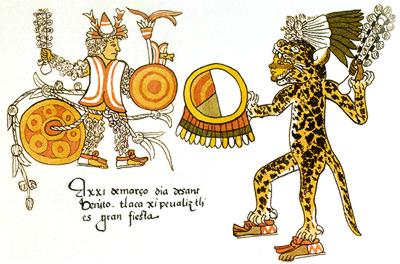
The Mexica people were neurotic. Tenochtitlan was the center of the empire
and the most neurotic. From birth to the grave the typical citizen of the
empire lived in a constant state of fear and apprehension. Fear that at any
moment the earth would end violently or a wandering deity might inflict
grave illness. The smallest deviance from a well defined daily regiment may
unleash personal misfortune or an even greater wrath from the gods upon
society as a whole. The universe was in complete chaos. Even the sun's
ability to rise each morning was in doubt. The Aztec believed they were
governed by fate and had no real control over their daily lives. The
concept of an afterlife was foreign and death was final(*40).
The Mexica world was full of omens, both good and bad. One had to
constantly be alert for signs and pay strict attention to daily routine and
ritual. A bird singing, a stone overturned, the sound of the wind - every
aspect of nature was speaking and the Aztec had to listen, intently. There
was one religion and the earth was doomed. Melancholy, pessimism, and dread
engulfed the Aztec mocking life itself.

Depression must have been everywhere and so commonplace that it must have
been thought of as a normal condition. There was no happiness in Mexica
society. Childhood was a gauntlet of pain and self denial. Adolescence was
manipulated toward state behavior control with sex used as a controlling
weapon(*41). Adulthood became a zombie like existence with obedience, self
blood letting, and deity worship at the core. Only if a person was lucky
enough to reach old age was there some relief. At that time they were
allowed to indulge themselves with alcohol until death finally overcame them.
Society had developed into a ritualistic parody of free will. The average
man went about his daily routine as if following a written script. Their
religion was their purpose in life. Success in life certainly was measured
in acquired wealth, however, the poorest man who kept his routine was well
respected in his community. After all, even wealth was pre-ordained by the
gods and luck or hard work had little or nothing to do with it.
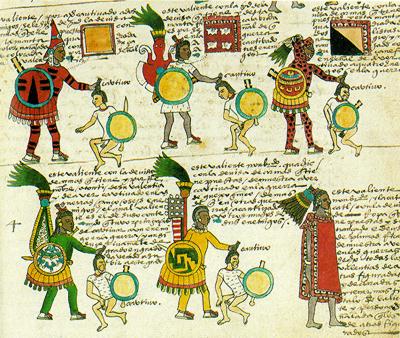
The Mexica citizen was surrounded by a well ordered and structured society
that publicly displayed constant reminders that the world was in perpetual
turmoil and may perish at any moment and for no reason. The yearly calendar
was one long festival and daily reminder for the proper homage to the
deities. As related by Diaz, Duran and Sahagun, public displays of mass
executions and torture were daily public events.
The daily routine was a constant regiment of ritual that included bloodletting and sacrifice. A common misconception of the Mexica is they had no regard for human life. Nothing could be farther from the truth. The Mexica viewed human life and blood as the most precious thing in nature. What better to offer the deities than the most precious element they possessed? The collective effect of years of this type of behavior and paranoia is immeasurable by our standards today. We must guess at the consequences on the mental health of the average individual.
Many scholastic history books depict the Mexica as Nobel warriors, with a great and powerful expanding society and as empire builders. It would be just as easy to depict them as a nation of hopeless neurotics, letting blood from their genitals before leaving their house in case a deity was offended, causing a giant rock to fall out of the sky and kill them. They didn't just think this was possible, they believed it! What is worse is if we are to believe such historians as Sahagun and Duran, that they taught these beliefs to their children.
Imagine a society where a man rubs dead spiders on his skin, never takes a
bath, and keeps his hair matted(*42) with blood. This man even buys babies
from your neighborhood to rip their hearts out for the gods, and then eats
the remaining parts. Further imagine that you envy his job - because it's
better than yours as a collector of public excrement. There must have been
someone who had the job to keep the heads of people be-headed stuck on
poles and facing the proper direction. Of even sillier note someone had to
interview him for the position. "Tell me, do you have any experience in
impaling a blood dripping head on a pole?" (I'll just bet someone said they
were a quick learner).
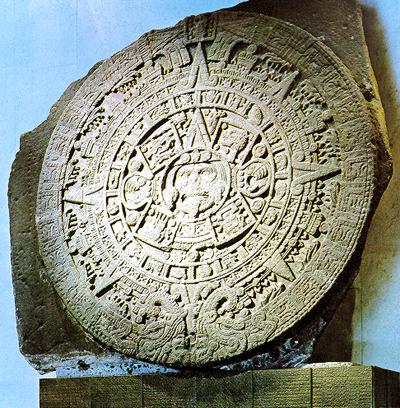
The criminals of this society were odd. Thieves would actually carry around
the severed left arm of a woman who died in childbirth, and think they were
invisible. Worse yet, if one of them entered your house, you would pretend
not to see them as they made off with your property and assaulted your wife
and daughters. These thieves were invisible and if you could actually see
them, you might be accused of a type of heresy and killed yourself.
Leaving your house for a simple errand would add to your neurosis. Walking to the public market on any given day you might witness public sacrifices, or have to dodge a rolling head falling from the steps of a temple. Children being carried on litters up to the mountains for sacrifice. Warriors and priests wearing the rotting skins of their victims was another common public sight. Upon reaching the market you might witness body parts for sale. There was no place in Mexica society that did not constantly assault the common man with pageantry, blood and ritual.
How the human mind would develop and what psychiatric problems existed, no one really knows, but we can suppose. We now universally accept that we are a product of our environment and that environment shapes us into what we become as adults. We now know that abused children are greatly pre-disposed to abuse their children in like ways. The Mexica were conditioned from birth to follow orders and not question their lot in life. Stress was ever present in their daily lives. We do know from records that the Mexica suffered a host of stomach and intestinal ailments. It would not be difficult to make a stress related argument for some of the causes of these disorders.
Where the physical side of Aztec health might be considered relatively good, the mental health of the population might be thought of as poor. The average man was melancholy and depressed. A prisoner of fate and destiny. Free will was nonexistent. The average woman burdened with natural maternal drives that were in conflict with masochistic societal pressure.
In some ways women fared worse than men. Men could always lose themselves
in combat and strictly male oriented pursuits. Women were forced to keep
house and their behavior quite regulated. Women were treated as little more
than slaves. Their sexual lives were controlled as well as their home life.
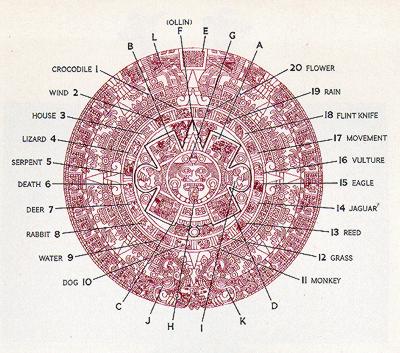
What is most frightening is the willingness of the parents to inflict this
society on their children. The worst case of child abuse you may be
familiar with would pale in comparison to the daily upbringing of children
in Aztec society. The children were raised in a world of real monsters, and
their priests only too willing to kill and eat them. The Mexica had to
invent a deity to come to their children's beds at night and help bring
them sleep(*43), the nightmares must have been horrible.
We do know that these children grew to adulthood and must have brought a host of mental problems with them. When it came time to start a family these disturbed adults raised their children the only way they knew. They raised a new generation of monsters. Generation after generation the Aztec added to their religious rituals. And with each generation they evolved into even more neurotic creatures. There is no model that we might judge them by.
The biological or "disease" side of mental illness is more difficult to speculate on. Certainly the population carried a proportionate amount of illness to our own modern civilizations. Where the correlation may tend to differ is the size of the gene pool that carried these natural mental desires. Modern societies tend to isolate and control an individual with anti-social characteristics. In our society they do not tend to reproduce themselves in a disproportionate manner, in fact society may even act as a deterrence to their reproduction.
In Mexica society any rational individual probably would have been quickly selected for sacrifice and tended not to reproduce. The effect of generations of an anti-social population breeding and weeding out what we may think of today as "normal" rational people, certainly would contaminate the gene pool. This would result in a higher national rate of biologically inherited mental diseases and illnesses.
We would consider the Mexica individual as insane by our modern standards. Mexica society was certainly considered inhuman by many. The Spanish soon after the conquest did everything in their power to burn the Mexica books and destroy any trace of the Mexica civilization. The Spanish saw nothing worth preserving. It is only by sheer luck that a handful of individuals, much after the conquest and in the nick of time, recorded what little information survives(*44). Just what did the Spanish see?
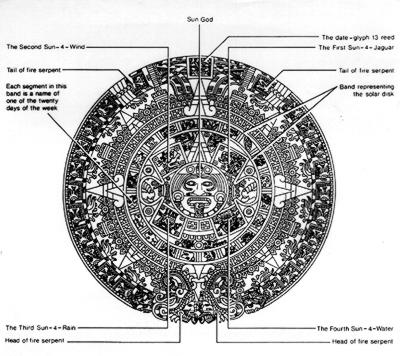
42 It is believed that the priests did not wash their hair as a sort of penance or "giving themselves to dirt" in honor of their gods.
44 By the time Duran and Sahagun began talking to old men and asking questions about the old Aztec civilization, these old men had been well schooled in the concept of heresy. Just how truthful these old men were in relating the true horror is not known. An argument could be made that they only related enough to satisfy the priests.
Other Aztec resources: